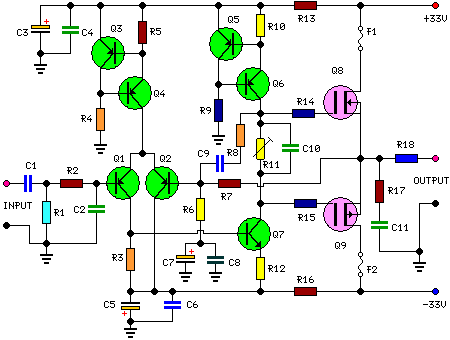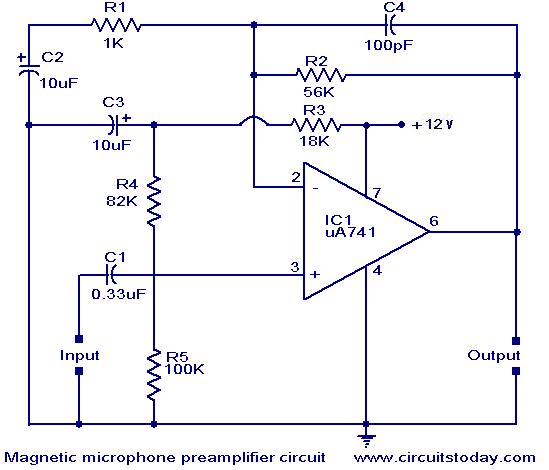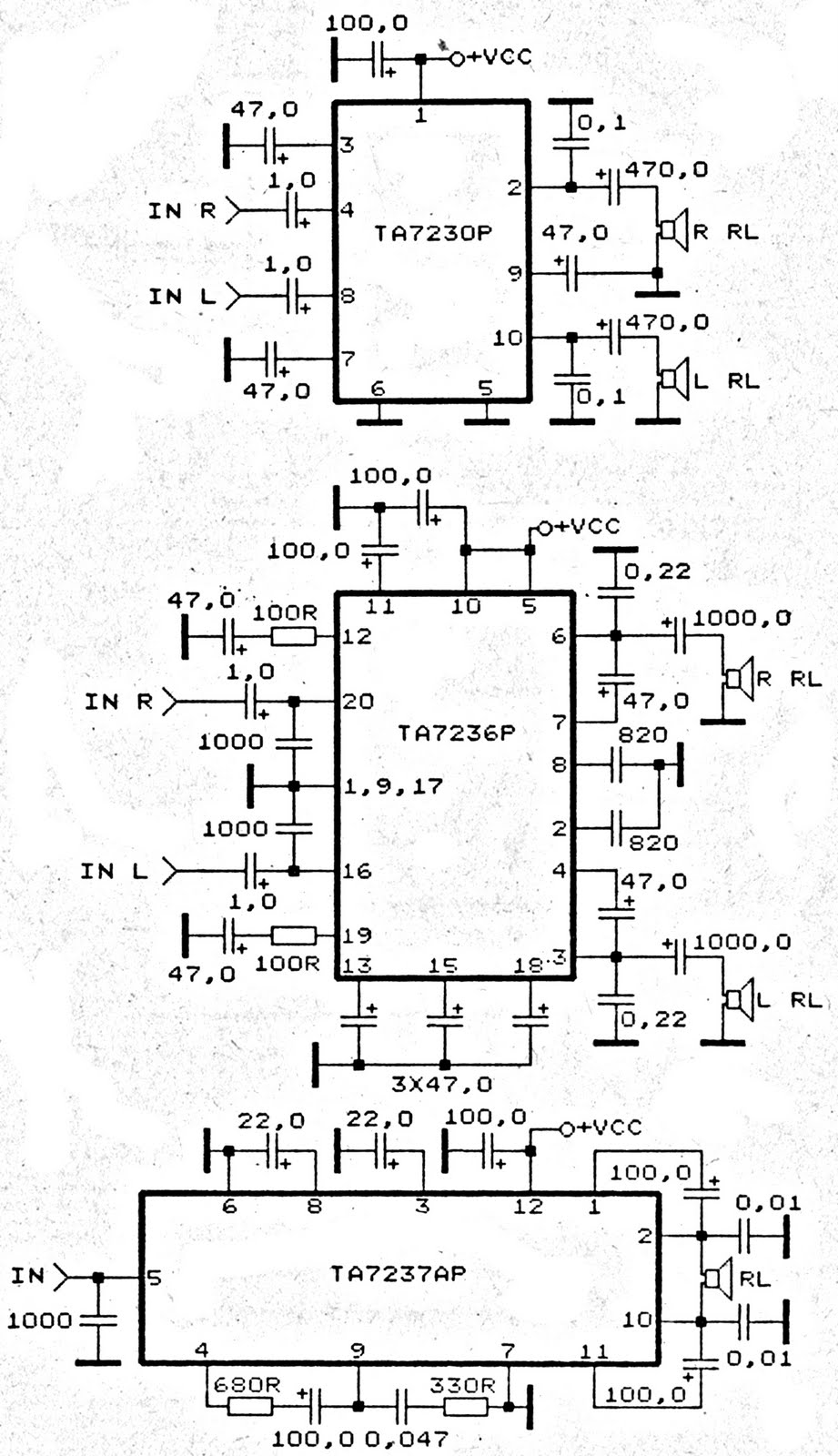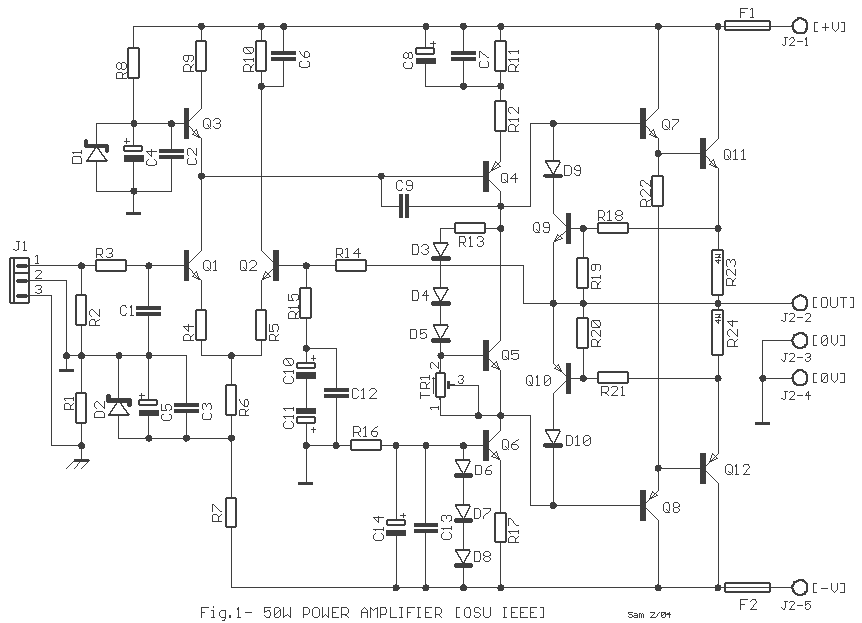
Hybrid Headphone Amplifier
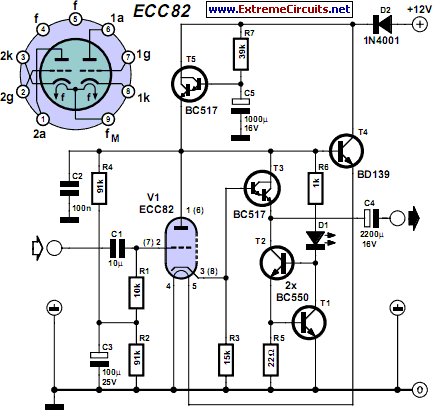
Headphone listening can be technically superior as it eliminates room reflections, and the close contact between the transducer and the ear requires only minimal power. This small power requirement allows transducers to operate at a fraction of their full excursion capabilities, reducing total harmonic distortion (THD) and other non-linear distortions. The design of a dedicated headphone amplifier may be considered controversial as it features unity voltage gain and incorporates both valves and transistors. Standard headphones typically have an impedance of 32 ohms per channel. The standard line output of 775 mV, which is the target for quality equipment, produces a power of U²/R = 0.775²/32 = 18 mW per channel across headphones with that impedance. An analysis of available headphones in well-known retail stores shows sensitivities ranging from 96 dB to 103 dB/mW. Consequently, the circuit can achieve high volume levels with unity gain. A low distortion output stage is feasible, with the emitter follower being an obvious choice due to its nearly unity gain and significant local feedback. However, the output impedance of an emitter follower is influenced by the source impedance, which can lead to slight, but noticeable, changes in sound quality with varying volume controls or signal sources. To address this, the output stage is driven by a cathode follower, utilizing an ECC82 valve (US equivalent: 12AU7), allowing the output stage to be driven with a constant low impedance. This configuration promotes low overall THD. Given the modest output power requirements, a Class A circuit is employed, featuring a single-ended output stage consisting of T3 and a constant current source formed by T1 and T2. The constant current is established by the Vbe voltage of T1 across R5, set to 22 ohms, resulting in a current of 27 mA. T3 operates in emitter follower mode, exhibiting high input impedance and low output impedance. A BC517 transistor is selected for T3 due to its high current gain of 30,000 at 2 mA. The low impedance output stage allows for capacitive coupling via C4. While some purists may object to using an electrolytic capacitor for this purpose, the distortion from capacitive coupling is significantly lower than that from transformer coupling. The remaining circuitry conditions the various voltages used in the design. To achieve a linear output, the valve grid must be biased at half the supply voltage, which is accomplished by the voltage divider R4 and R2. Input signals enter the circuit through C1 and R1, with R1 defining the input impedance and C1 ensuring a response down to 2 Hz. Although the circuit effectively rejects line noise due to the high impedance of the anode of V1 and the collector current of T3, additional noise reduction is provided by a capacitance multiplier circuit centered around T5, another BC517, which avoids loading the filter composed of R7 and C5. The capacitance of C5 is multiplied by the gain of T5, resulting in a low impedance at its emitter. This configuration also allows for a gradual application of the supply voltage upon startup, as C5 charges through R7, ensuring no hum or ripple is present. C2 is included to maintain stability at radio frequencies (RF). The DC supply also powers the valve heater; the ECC82 can operate at 12.6 V, with T4 serving as a series pass element. The base voltage for T4 is derived from the emitter of T5. T4 has a low output impedance of approximately 160 mΩ, which minimizes the risk of interference from heater wiring. Additionally, connecting the base of the transistor to C5 allows for a gentle warm-up of the valve heater, with minimal voltage loss across T4, which operates without the need for a heat sink.Potentially, headphone listening can be technically superior since room reflections are eliminated and the intimate contact between transducer and ear mean that only tiny amounts of power are required. The small power requirement means that transducers can be operated at a small fraction of their full excursion capabilities thus reducing THD and o
ther non-linear distortions. This design of a dedicated headphones amplifier is potentially controversial in that it has unity voltage gain and employs valves and transistors in the same design. Normal headphones have an impedance of 32R per channel. The usual standard line output of 775 mV to which all quality equipment aspires will generate a power of U2 / R = 0.
7752 / 32 = 18 mW per channel across a headphone of this impedance. An examination of available headphones at well known high street emporiums revealed that the sensitivity varied from 96 dB to 103db/mW! So, in practice the circuit will only require unity gain to reach deafening levels. As a unity gain design is required it is quite possible to employ a low distortion output stage. The obvious choice is an emitter follower. This has nearly unity gain combined with a large amount of local feedback. Unfortunately the output impedance of an emitter follower is dependent upon the source impedance. With a volume control, or even with different signal sources this will vary and could produce small but audible changes in sound quality.
To prevent this, the output stage is driven by a cathode follower, based around an ECC82 valve (US equivalent: 12AU7). This device, as opposed to a transistor configuration, enables the output stage to be driven with a constant value, low impedance.
In other words, the signal from the low impedance point is used to drive the high impedance of the output stage, a situation which promotes low overall THD. At the modest output powers required of the circuit, the only sensible choice is a Class A circuit. In this case the much vaunted single-ended output stage is employed and that comprises of T3 and constant current source T1-T2.
The constant current is set by the Vbe voltage of T1 applied across R5 With its value of 22R, the current is set at 27 mA. T3 is used in the emitter follower mode with high input impedance and low output impedance. Indeed the main problem of using a valve at low voltages is that it`s fairly difficult to get any real current drain.
In order to prevent distortion the output stage shouldn`t be allowed to load the valve. This is down to the choice of output device. A BC517 is used for T3 because of its high current gain, 30, 000 at 2 mA! Since we have a low impedance output stage, the load may be capacitively coupled via C4. Some purists may baulk at the idea of using an electrolytic for this job but he fact remains that distortion generated by capacitive coupling is at least two orders of magnitude lower than transformer coupling. The rest of the circuitry is used to condition the various voltages used by the circuit. In order to obtain a linear output the valve grid needs to be biased at half the supply voltage. This is the function of the voltage divider R4 and R2. Input signals are coupled into the circuit via C1 and R1. R1, connected between the voltage divider and V1`s grid defines the input impedance of the circuit. C1 has sufficiently large a value to ensure response down to 2 Hz. Although the circuit does a good job of rejecting line noise on its own due to the high impedance of V1`s anode and T3`s collector current, it needs a little help to obtain a silent background in the absence of signal.
The help` is in the form of the capacitance multiplier circuit built around T5. Another BC517 is used here to avoid loading of the filter comprising R7 and C5. In principle the capacitance of C5 is multiplied by the gain of T5. In practice the smooth dc applied to T5`s base appears at low impedance at its emitter. An important added advantage is that the supply voltage is applied slowly on powering up. This is of course due to the time taken to fully charge C5 via R7. No trace of hum or ripple can be seen here on the scope. C2 is used to ensure stability at RF. The DC supply is also used to run the valve heater. The ECC82 has an advantage here in that its heater can be connected for operate from 12. 6 V. To run it T4 is used as a series pass element. Base voltage is obtained from the emitter of T5. T4 has very low output impedance, about 160 mR and this helps to prevent extraneous signals being picked up from the heater wiring. Connecting the transistor base to C5 also lets the valve heater warm up gently. A couple of volts only are lost across T4 and although the device runs warm it doesn`t require a heat-sink.
🔗 External reference
ther non-linear distortions. This design of a dedicated headphones amplifier is potentially controversial in that it has unity voltage gain and employs valves and transistors in the same design. Normal headphones have an impedance of 32R per channel. The usual standard line output of 775 mV to which all quality equipment aspires will generate a power of U2 / R = 0.
7752 / 32 = 18 mW per channel across a headphone of this impedance. An examination of available headphones at well known high street emporiums revealed that the sensitivity varied from 96 dB to 103db/mW! So, in practice the circuit will only require unity gain to reach deafening levels. As a unity gain design is required it is quite possible to employ a low distortion output stage. The obvious choice is an emitter follower. This has nearly unity gain combined with a large amount of local feedback. Unfortunately the output impedance of an emitter follower is dependent upon the source impedance. With a volume control, or even with different signal sources this will vary and could produce small but audible changes in sound quality.
To prevent this, the output stage is driven by a cathode follower, based around an ECC82 valve (US equivalent: 12AU7). This device, as opposed to a transistor configuration, enables the output stage to be driven with a constant value, low impedance.
In other words, the signal from the low impedance point is used to drive the high impedance of the output stage, a situation which promotes low overall THD. At the modest output powers required of the circuit, the only sensible choice is a Class A circuit. In this case the much vaunted single-ended output stage is employed and that comprises of T3 and constant current source T1-T2.
The constant current is set by the Vbe voltage of T1 applied across R5 With its value of 22R, the current is set at 27 mA. T3 is used in the emitter follower mode with high input impedance and low output impedance. Indeed the main problem of using a valve at low voltages is that it`s fairly difficult to get any real current drain.
In order to prevent distortion the output stage shouldn`t be allowed to load the valve. This is down to the choice of output device. A BC517 is used for T3 because of its high current gain, 30, 000 at 2 mA! Since we have a low impedance output stage, the load may be capacitively coupled via C4. Some purists may baulk at the idea of using an electrolytic for this job but he fact remains that distortion generated by capacitive coupling is at least two orders of magnitude lower than transformer coupling. The rest of the circuitry is used to condition the various voltages used by the circuit. In order to obtain a linear output the valve grid needs to be biased at half the supply voltage. This is the function of the voltage divider R4 and R2. Input signals are coupled into the circuit via C1 and R1. R1, connected between the voltage divider and V1`s grid defines the input impedance of the circuit. C1 has sufficiently large a value to ensure response down to 2 Hz. Although the circuit does a good job of rejecting line noise on its own due to the high impedance of V1`s anode and T3`s collector current, it needs a little help to obtain a silent background in the absence of signal.
The help` is in the form of the capacitance multiplier circuit built around T5. Another BC517 is used here to avoid loading of the filter comprising R7 and C5. In principle the capacitance of C5 is multiplied by the gain of T5. In practice the smooth dc applied to T5`s base appears at low impedance at its emitter. An important added advantage is that the supply voltage is applied slowly on powering up. This is of course due to the time taken to fully charge C5 via R7. No trace of hum or ripple can be seen here on the scope. C2 is used to ensure stability at RF. The DC supply is also used to run the valve heater. The ECC82 has an advantage here in that its heater can be connected for operate from 12. 6 V. To run it T4 is used as a series pass element. Base voltage is obtained from the emitter of T5. T4 has very low output impedance, about 160 mR and this helps to prevent extraneous signals being picked up from the heater wiring. Connecting the transistor base to C5 also lets the valve heater warm up gently. A couple of volts only are lost across T4 and although the device runs warm it doesn`t require a heat-sink.
🔗 External reference
Warning: include(partials/cookie-banner.php): Failed to open stream: Permission denied in /var/www/html/nextgr/view-circuit.php on line 713
Warning: include(): Failed opening 'partials/cookie-banner.php' for inclusion (include_path='.:/usr/share/php') in /var/www/html/nextgr/view-circuit.php on line 713
